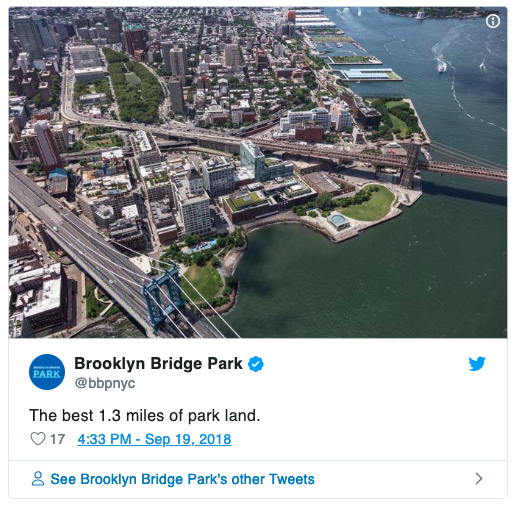Introducing “Parks We Love” blog series: Brooklyn Bridge Park
The Trustees’ One Waterfront initiative is a bold, new vision for establishing a resilient urban waterfront. Yes, the vision is bold, and new for Boston, but we have the benefit of following in the footsteps of those who have paved the way. Many waterfront parks designed for climate resiliency have emerged over the past few decades all along the world’s coastlines and are models to emulate and learn from.
This week we introduce a new series to the Waterfront Views blog called “Parks We Love” in which we will profile some of these inspiring waterfront spaces. These parks have not only become iconic, public destinations for their respective cities, but serve as critical infrastructure in shoreline protection and are helping to meet climate change preparedness goals.
The lessons learned from these pioneering open spaces—in science, design, and beyond—have and will continue to provide The Trustees and our partners with an expansive knowledge base for planning practices as we progress toward our vision for iconic, public open spaces on the Boston Waterfront.
We start with the Brooklyn Bridge Park, as it exemplifies so many best practices for resiliency and planning for a sustainable waterfront in a city vulnerable to major weather events. This 85-acre open space was built on reclaimed shipping piers and ferry landings stretching 1.3 miles along Brooklyn’s East River. The vision of the Brooklyn Bridge Park Conservancy, a non-profit which built and manages the park, was to “create and maintain a world class park that is a recreational, environmental, and cultural destination enjoyed by the residents of, and visitors to, New York City.”
And that they did. Over the course of 25 years, through an intense community engagement process, Brooklyn Bridge Park Conservancy transformed a previously deteriorated stretch of waterfront into a world-class park with a diverse mix of uses where the public can gather, play, kick back, and enjoy sweeping views of New York Harbor. Today the award-winning park serves as a premier destination for more than four million visitors each year, offering respite from city life along with an abundance of recreational, educational, and entertainment programs. The park has a rich mix of amenities including playgrounds, sports fields, expansive lawns, boat launches and the historic Jane’s Carousel. Brooklyn Bridge Park is made up of six piers interconnected by a mile-long greenway. Each pier has a unique design and program that serves the community. Thousands of people from all walks of life visit the park daily to relax, exercise, picnic and partake in the many diverse learning and cultural opportunities offered by the Conservancy.
Brooklyn Bridge Park experienced its first big test in resilient design when Hurricane Sandy devastated much of New York’s coastal areas in 2012. During the storm, much of the park was underwater for more than four hours, yet it emerged relatively unscathed, performing its storm surge mitigation role as intended.
The park’s architects, Michael Van Valkenburgh Associates (MVVA), designed it to withstand storms and floods by incorporating a variety of wetlands, meadows, and other resilient ecosystems with native plantings into the landscape.
The architects also designed the topography to block or absorb incoming flood waters with berms and salt marshes that otherwise would have damaged surrounding neighborhoods. Salt-tolerant plants such as beach plum, baccharis, and pitch pine were selected for long-term survival. Sandy soil was installed to help salt water drain quickly. Excess stormwater from the park traverses a series of landscape elements that treat the water ecologically before being stored underground for future irrigation needs.
Permeable and climate-resilient materials were used to help foster marine growth, and create greater biodiversity for fauna. Salvaged materials—from pier timbers and granite, to fill from the fallen World Trade Center—comprise much of the park’s constructed infrastructure. Native marine and bird habitats were designed to flourish with minimum human impact. And recently, Brooklyn Bridge Park teamed with the Billion Oyster Project to restore oysters in New York Harbor which, in turn, filter the water to improve the marine habitat of crabs, blackfish, and sea life critical to the harbor’s ecology.
Because of their inspiring work on Brooklyn Bridge Park, MVVA was hired by The Trustees to work on initial concepts for potential Boston waterfront parks. Their early renderings can be seen on the One Waterfront website by clicking here.

